Pressure washing is not merely a cleaning method; it is an effective technique that revitalizes surfaces and enhances the overall appearance of a property. This process entails a comprehensive understanding of pressure washing, its operational principles, and the myriad benefits it provides, ranging from improved curb appeal to damage prevention. One will gain insight into the various surfaces that can be effectively cleaned, the essential equipment required, and crucial safety protocols to ensure a successful pressure washing experience. Explore how this straightforward process can substantially impact the maintenance and upkeep of your home.
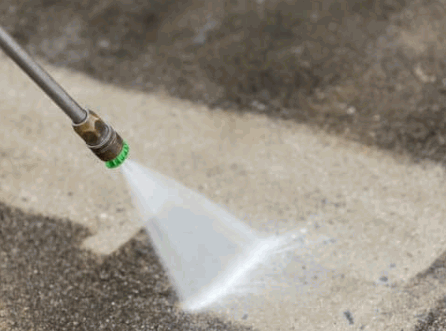
What Is Pressure Washing?
Pressure washing is an effective exterior cleaning technique that employs high-pressure water spray to eliminate dirt buildup, mold, mildew, and other contaminants from surfaces, thereby significantly enhancing curb appeal and property value.
Major cities on Long Island, including Upper Brookville, Oyster Bay, Westbury, and Massapequa, have experienced a growing demand for professional pressure washing services, particularly in preparation for property renovations and the maintenance of residential and commercial spaces.
Plus restoring the appearance of various surfaces, pressure washing also plays a crucial role in health and safety by preventing the growth of mold and mildew, which can contribute to health issues such as asthma.
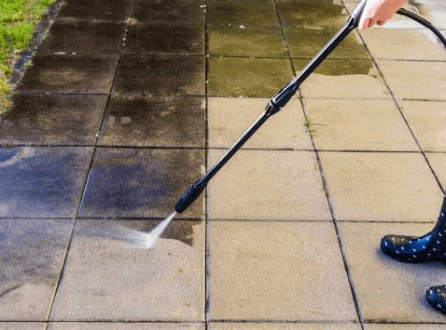
How Does Pressure Washing Work?
Pressure washing employs specialized equipment known as pressure washers, which propel water at high velocity to effectively clean surfaces by removing dirt buildup, grime, and other unwelcome contaminants.
A comprehensive understanding of pressure washing entails recognizing the various techniques utilized based on the surface being cleaned and the type of contaminants present. For example, soft washing is particularly suited for delicate surfaces, such as roofs or painted areas, where low pressure is essential to prevent damage. Conversely, commercial-grade pressure washers are capable of delivering higher pressure, making them more appropriate for resilient surfaces like concrete or brick.
Pressure washers are available in a range of models, from electric options, which operate quietly and are ideal for lighter tasks, to gas-powered machines that offer greater power for more extensive cleaning projects.
- Rotary nozzles can be utilized for deeper scrubbing.
- Detergent injectors enhance the cleaning process by effectively breaking down stubborn grime.
By selecting the appropriate machine and cleaning solutions, one can achieve exceptionally effective cleaning results, showcasing the true potential of this efficient method.
Look into: Can You Pressure Wash The Roof
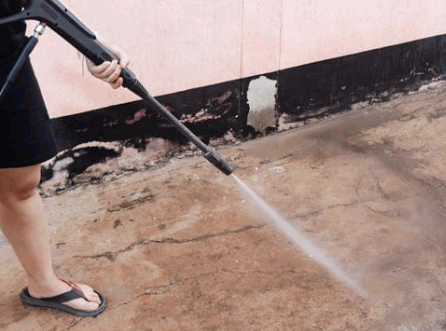
What Are The Benefits Of Pressure Washing?
The advantages of pressure washing extend well beyond surface aesthetics, as it is instrumental in enhancing property value, safeguarding investment, and promoting health by removing harmful mold and mildew from surfaces.
Both homeowners and commercial property managers can recognize the substantial improvement in curb appeal that pressure washing provides, making it a cost-effective solution for residential maintenance and seasonal cleaning requirements.
Increases Curb Appeal
One of the most immediate advantages of pressure washing is its ability to significantly enhance a property’s curb appeal, rendering it fresh and inviting. Curb appeal plays a vital role in attracting potential buyers, as first impressions often dictate interest levels in a home.
When investing in residential maintenance, research indicates that homes with meticulously maintained exteriors can achieve a return on investment (ROI) of up to 15% higher than comparable properties that lack proper upkeep. For instance, a study conducted by the National Association of Realtors suggests that a well-kept landscape can contribute as much as 10% to a home’s value. Additionally, a recent analysis revealed that homes that underwent pressure washing sold 25% faster than their less polished counterparts.
These compelling statistics underscore the importance of maintaining a pristine exterior, highlighting the necessity of prioritizing regular maintenance. Pressure washing not only enhances the aesthetics of a property but also reflects a commitment to property care that resonates with buyers in a competitive market.
Removes Stubborn Stains And Dirt
Pressure washing is highly effective for the removal of stubborn stains, dirt buildup, and debris from various surfaces, including driveways, decks, and siding.
By utilizing a combination of high-pressure water and specialized cleaning solutions, pressure washing techniques can address a wide range of contaminants. For instance, oil and grease stains on concrete driveways can be effectively eliminated using a degreaser that breaks down tough residues, allowing the high-pressure water to wash them away with ease.
In the case of wooden decks, it is often necessary to apply a mildewcide to eliminate mold and mildew prior to conducting pressure washing. This dual approach not only enhances cleanliness but also extends the longevity of the surface.
- For vinyl siding, a mixture of detergent and water applied at low-pressure settings can restore its original color and shine.
- Commercial properties, such as storefronts, benefit from the removal of graffiti through the use of specific removal agents that complement pressure washing techniques.
Ultimately, these methods demonstrate the versatility of pressure washing in maintaining the aesthetic appeal and hygiene of both residential and commercial spaces, solidifying its status as a preferred choice among property owners.
Prevents Damage To Surfaces
Regular pressure washing is essential for preventing damage to surfaces by removing harmful mold and mildew that can lead to deterioration over time.
By adopting a routine pressure washing schedule, property owners can significantly enhance the longevity of their building materials. Consistent cleaning eliminates the buildup of grime and biological growth that not only detracts from aesthetic appeal but also compromises structural integrity. By addressing these common contaminants, property owners can avoid the costly repairs that arise from neglect and resulting damage.
Ensuring safety during pressure washing is of paramount importance; it requires the selection of appropriate techniques and protective measures to safeguard both the operators and the surfaces being cleaned.
- Utilizing the correct pressure settings is crucial to prevent surface damage.
- Employing protective gear, such as goggles and gloves, helps mitigate personal injury risks.
- Implementing eco-friendly cleaning agents further protects both the environment and the surfaces being treated.
Ultimately, regular pressure washing is a vital investment in maintaining property health and enhancing overall value.
Saves Time And Effort
Investing in pressure washing services provides homeowners and property managers with a significant advantage in terms of both time and effort. This efficient cleaning solution accomplishes in moments what would otherwise require hours or even days using conventional methods.
Not only does this approach yield outstanding results, but it also improves the overall appearance and durability of surfaces, thereby minimizing the necessity for costly repairs. When evaluating the actual pressure washing costs, clients will discover that this investment proves to be highly beneficial over time.
- Cost-effectiveness: Engaging professional services eliminates the need for the purchase and maintenance of expensive equipment.
- Time savings: Trained professionals can complete the task in a fraction of the time it would take an untrained individual, allowing clients to allocate their time to other important responsibilities.
- Long-term value: Regular pressure washing helps prevent the accumulation of dirt, thereby extending the lifespan of property features and enabling homeowners to manage their investments more effectively.
These advantages underscore how choosing professional pressure washing can result in significant savings and enhanced property value over the long term.
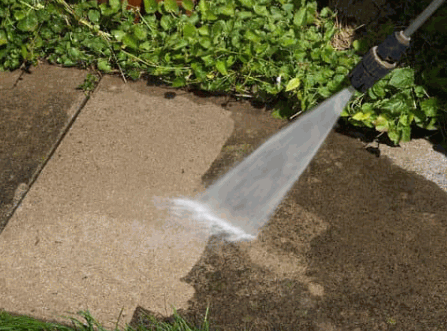
What Surfaces Can Be Pressure Washed?
Pressure washing is a highly versatile method that can be effectively applied to a range of surfaces, including concrete, brick, wood, vinyl siding, and outdoor furniture. This capability makes it an invaluable tool for the maintenance of both residential and commercial properties.
Concrete
Concrete is one of the most prevalent surfaces for pressure washing, as it is prone to the accumulation of dirt and stains over time.
As time progresses, concrete surfaces—including driveways, patios, and sidewalks—can become unattractive due to environmental factors such as mud, grime, and oil stains. Regular pressure washing is an effective method for restoring these surfaces to their original condition, providing not only aesthetic improvements but also extending the lifespan of the concrete.
To achieve optimal results and enhance curb appeal, homeowners frequently utilize specific pressure washing techniques, including varying nozzle sizes to control the water force and adjusting the pressure settings based on the type of stain present. This approach can significantly boost home value by maintaining the exterior’s aesthetic.
- Cleaning Solutions: Many individuals opt for eco-friendly cleaning solutions specifically formulated for concrete, which effectively break down stubborn stains while minimizing harm to the surrounding landscape.
- Technique Considerations: A systematic approach, such as cleaning in sections, ensures comprehensive coverage and efficient removal of built-up substances.
The advantages of maintaining concrete through regular pressure washing are significant, as this practice not only enhances visual appeal but also prevents long-term damage, ultimately reducing costs associated with more extensive repairs. Regular pressure washing, a crucial part of property maintenance, can also help in mildew prevention, thereby safeguarding the structural integrity.
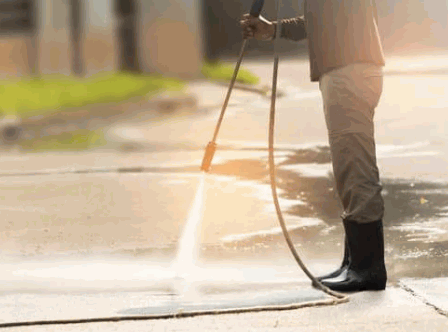
Brick
Brick surfaces derive substantial benefits from pressure washing, as this method effectively removes mold, mildew, and other contaminants that may compromise their structural integrity. This brick cleaning also contributes to restoring appearance and enhances the overall value of the property.
By employing appropriate pressure levels and techniques, one can ensure that the cleaning process not only revitalizes the surface but also extends its lifespan. This approach is particularly advantageous for outdoor brick installations, which are more susceptible to the growth of harmful substances. To achieve optimal results, the following methods should be considered:
- Adjusting Pressure Levels: It is essential to identify the appropriate pressure setting. Excessively high pressure may damage the brick, while insufficient pressure will not effectively clean the surface.
- Selecting the Right Nozzle: Different nozzles yield various spray patterns. Utilizing a wider spray can distribute the pressure over a larger area, thereby being gentler on the brick.
- Using Eco-Friendly Detergents: Incorporating a cleaning solution can significantly enhance the removal of stubborn grime, mold, and mildew, thereby contributing to both aesthetic appeal and health benefits for individuals with sensitivities.
Regular maintenance utilizing this technique can prevent the recurrence of health hazards associated with mold and mildew, ensuring a safe and visually appealing environment.

Wood
Wood surfaces, including decks and siding, necessitate careful pressure washing to prevent damage; thus, adherence to pressure washing safety guidelines is imperative. Regular deck cleaning can significantly contribute to investment protection by preserving the wood’s longevity.
When performing pressure washing on wood surfaces, it is essential to utilize the appropriate settings to avoid creating splinters or gouges. Typically, the following pressure settings are recommended:
- 1,200 to 1,500 PSI for softer woods
- 1,500 to 3,000 PSI for harder woods
Employing environmentally friendly cleaning solutions can significantly improve results while safeguarding the integrity of the wood. Products such as biodegradable wood cleaners effectively eliminate dirt and stains without causing harm to the surface.
Regular maintenance is crucial in preserving the aesthetic appeal and functionality of wood materials. By scheduling periodic cleanings and inspections, which could be part of a broader property maintenance strategy, it is possible to identify issues early and implement necessary treatments, thereby extending the life of these valuable investments and ensuring investment savings.

Vinyl Siding
Vinyl siding is an ideal surface for pressure washing, as it facilitates effective cleaning without compromising the integrity of the material.
To achieve optimal results, it is essential to employ several specific techniques. First, one should utilize the appropriate settings on the pressure washer; typically, a nozzle with a 25- or 40-degree angle is recommended. The incorporation of cleaning solutions specifically formulated for vinyl materials can further enhance the washing process.
Commonly used solutions include:
- A mixture of water and dish soap
- Commercial vinyl siding cleaners
- Combinations of baking soda and vinegar
It is imperative to maintain a safe distance from the surface being cleaned, generally around 6 to 8 feet, to avoid any potential damage. Regular maintenance not only ensures the aesthetic value of the siding is preserved, but also protects the underlying structure of the home from potential issues such as mold and mildew growth.
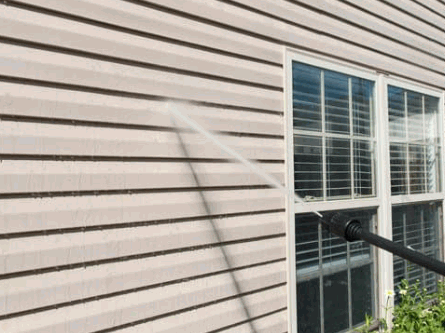
What Equipment Is Needed For Pressure Washing?
Engaging a professional pressure washing company like can ensure the use of appropriate techniques and equipment.
To perform pressure washing effectively, several essential pieces of equipment are required, including a pressure washer, suitable cleaning solutions, and protective gear to ensure safety throughout the cleaning process.
Pressure Washer
A pressure washer serves as the essential equipment for pressure washing, available in various models tailored to different cleaning tasks according to their pressure output.
Pressure washers can be broadly classified into electric, gas-powered, and hot water units, each presenting distinct advantages suited to specific cleaning requirements. Proper selection can lead to investment savings by minimizing property damage.
- Electric models are well-suited for lighter tasks such as washing vehicles, cleaning patio furniture, or rinsing sidewalks. Their user-friendly design and lower pressure output, typically ranging from 1300 to 1900 PSI, make them ideal for these applications.
- Gas-powered models, in contrast, offer greater power, making them appropriate for heavy-duty tasks such as cleaning driveways, decks, and exterior walls. These units often generate pressure levels exceeding 2000 PSI.
- Hot water pressure washers further enhance the cleaning process by utilizing heated water, thereby increasing effectiveness in removing grease and oil stains, particularly in commercial settings.
Furthermore, mastering the various pressure washing techniques associated with each type—such as adjusting nozzle settings and maintaining the proper distance from surfaces—can significantly enhance cleaning efficiency and overall results. In areas like Long Island and Oyster Bay, these techniques are crucial for maintaining home value.

Cleaning Solutions
Cleaning solutions play a vital role in enhancing the effectiveness of pressure washing, particularly for tasks related to mold removal and mildew prevention.
These formulations are available in various types, each specifically designed for particular applications and surfaces. For example, alkaline-based cleaners are commonly employed on hard surfaces such as concrete, as they effectively break down grease and grime. In contrast, acidic solutions are utilized to restore the natural shine of metal surfaces by eliminating rust and mineral deposits.
Eco-friendly options have gained traction due to their environmental safety features, enabling users to achieve effective cleaning without detrimental effects on surrounding flora and fauna. Using environment-friendly solutions is a significant aspect of pressure washing benefits, especially in outdoor cleaning tasks.
- Bleach Solutions: Effective for removing mold and mildew.
- Detergents: Ideal for addressing general dirt and grime on surfaces such as vinyl siding.
- Industrial-grade Cleaners: Recommended for heavy-duty applications in commercial environments.
Understanding the appropriate cleaning solution not only enhances results but also extends the lifespan of the surfaces being cleaned. This understanding is pivotal in investment protection and effective property maintenance.

Protective Gear
Wearing appropriate protective gear is essential when performing pressure washing, as it ensures safety and minimizes the risk of injury or health hazards.
This critical safety measure protects against potential injuries from high-pressure water jets, which can inflict serious harm, as well as from harmful chemicals frequently utilized in cleaning solutions. The appropriate protective equipment comprises several key components that collectively contribute to a safer working environment.
For instance:
- Eye Protection: Safety goggles or face shields safeguard the eyes from flying debris and hazardous chemicals.
- Gloves: Heavy-duty gloves protect the hands from cuts and chemical burns while providing a secure grip.
- Footwear: Sturdy, slip-resistant boots help prevent falls on wet surfaces.
- Hearing Protection: Earplugs or earmuffs mitigate noise exposure when operating loud pressure washing equipment.
Employees should receive training on proper safety protocols to ensure they utilize all protective gear effectively. By prioritizing health and safety, organizations not only reduce the likelihood of accidents but also foster a culture of safety within the workplace.

How To Safely Perform Pressure Washing?
To conduct pressure washing safely, it is imperative to adhere to a set of guidelines. This includes thoroughly reviewing the manual for the equipment, wearing appropriate protective gear, and employing correct pressure washing techniques. Such practices are integral to ensuring health improvement and preventing property damage.
Read The Manual
Reading the manual of your pressure washer is a crucial initial step in ensuring safe operation and comprehending the capabilities of the equipment.
Familiarizing oneself with this document not only enhances the user experience but also helps prevent potential accidents and equipment damage. The manual typically contains essential information, including:
- Operating instructions: Detailed guidance on how to effectively operate the machine.
- Safety precautions: Important safety tips designed to minimize risks during cleaning tasks, ensuring users are aware of potential hazards.
- Specifications: Insights into pressure ratings, flow rates, and the types of cleaning agents that can be safely utilized.
- Maintenance guidelines: Instructions on regular maintenance practices that can extend the lifespan of the equipment.
By dedicating time to reading and comprehending the manual, individuals can significantly enhance their safety and efficiency, thereby making pressure washing a more productive and rewarding endeavor.
Wear Protective Gear
Wearing appropriate protective gear, including goggles, gloves, and non-slip footwear, is essential for ensuring health and safety, as well as minimizing the risk of injury while pressure washing.
It is important to recognize that different types of protective equipment serve specific purposes, significantly enhancing safety during the pressure washing process. For example, goggles are designed to protect the eyes from flying debris and chemical splashes, which can result in serious injuries. Likewise, heavy-duty gloves are necessary to protect hands from high-pressure water streams, potential chemicals, and sharp objects, while also providing a secure grip. Non-slip footwear is critical, as wet surfaces can be hazardous, leading to slips and falls—an issue that accounts for approximately 27% of all accidents in cleaning operations.
Furthermore, it is advisable to include ear protection when utilizing electric pressure washers, as they can produce noise levels that are damaging to hearing. Face shields can also provide an additional layer of protection against splash hazards.
By utilizing the proper protective gear, individuals can significantly reduce risks and foster a safer working environment, underscoring the importance of prioritizing personal protection during this demanding task.
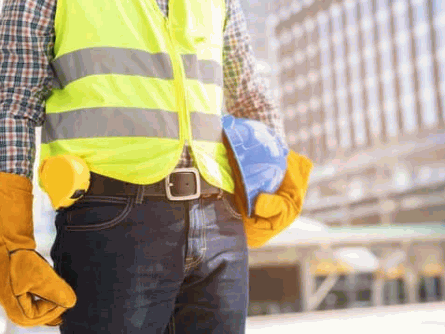
Test The Pressure On A Small Area
Before fully engaging in pressure washing, it is essential to conduct a preliminary test on a small area to ascertain the appropriate pressure settings. This step is crucial to ensure effective cleaning while preventing potential damage to the surfaces being treated.
To initiate the testing process, one should select a discreet area of the surface in question. It is advisable to begin with the lowest pressure setting to evaluate the material’s response, gradually increasing the pressure as necessary based on the observations made.
Careful observation of the surface’s reaction during the test is vital, as different materials, including wood, concrete, and vinyl, require specific adjustments to the pressure settings.
- For concrete surfaces, a moderate level of pressure typically yields excellent results while minimizing the risk of cracking.
- Wood surfaces necessitate careful assessment, as excessive pressure can strip away paint or cause splintering.
- Vinyl and other softer materials should be treated with lower pressure levels to prevent deformation.
After completing the test, it is important to evaluate the results by inspecting for any signs of damage, such as peeling paint or gouged surfaces. This meticulous approach will facilitate the determination of the correct pressure settings, ensuring effective cleaning without compromising the integrity of the surfaces.
Use Proper Techniques
Employing appropriate techniques during pressure washing is essential for achieving effective cleaning results while minimizing the risk of damage to surfaces.
To ensure successful outcomes, individuals should consider several key aspects of pressure washing methods. First, the angle of approach significantly impacts the results; a 45-degree angle is often recommended as it facilitates efficient dirt removal without compromising the integrity of the surfaces being cleaned.
Next, maintaining an appropriate distance from the surface is crucial; generally, a distance of 12 to 24 inches is advisable, depending on the pressure settings and the type of surface. Consistent movement patterns during the cleaning process can further enhance effectiveness; employing overlapping strokes helps to prevent streaks and ensures comprehensive coverage.
The following techniques may be beneficial to consider:
- Begin with a test spot to determine the ideal settings.
- Utilize a sweeping motion to cover larger areas.
- Adjust the pressure based on the material being cleaned.

